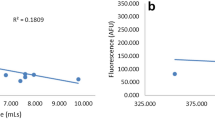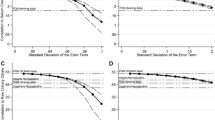Abstract
Reliable identification of features distinguishing biological groups of interest in urinary metabolite fingerprints requires the control of total metabolite abundance, which may vary significantly as the kidneys adjust the excretion of water and solutes to meet the homeostatic needs of the body. Failure to account for such variation may lead to misclassification and accumulation of missing data in case of less concentrated urine specimens. Here, different pre- and post-acquisition methods of normalization were compared systematically for their ability to recover features from liquid chromatography-mass spectrometry metabolite fingerprints of urine that allow distinction between patients with chronic kidney disease and healthy controls. Methods of normalization that were employed prior to analysis included dilution of urine specimens to either a fixed creatinine concentration or osmolality value. Post-acquisition normalization methods applied to chromatograms of 1:4 diluted urine specimens comprised normalization to creatinine, osmolality, and sum of all integrals. Dilution of urine specimens to a fixed creatinine concentration resulted not only in the least number of missing values, but it was also the only method allowing the unambiguous classification of urine specimens from healthy and diseased individuals. The robustness of classification could be confirmed for two independent patient cohorts of chronic kidney disease patients and yielded a shared set of 49 discriminant metabolite features.

Dilution to a uniform creatinine concentration across urine specimens yields more comparable urinary metabolite fingerprints





Similar content being viewed by others
References
Barr DB, Wilder LC, Caudill SP, Gonzalez AJ, Needham LL, Pirkle JL. Urinary creatinine concentrations in the US population: implications for urinary biologic monitoring measurements. Environ Health Perspect. 2005;113(2):192–200. doi:10.1289/ehp.7337 .
Ryan D, Robards K, Prenzler PD, Kendall M. Recent and potential developments in the analysis of urine: a review. Anal Chim Acta. 2011;684(1–2):8–20. doi:10.1016/j.aca.2010.10.035 .
Zhang A, Sun H, Wu X, Wang X. Urine metabolomics. Clin Chim Acta. 2012;414:65–9.
Warrack BM, Hnatyshyn S, Ott K-H, Reily MD, Sanders M, Zhang H, et al. Normalization strategies for metabonomic analysis of urine samples. J Chromatogr B. 2009;877(5):547–52.
Boeniger MF, Lowry LK, Rosenberg J. Interpretation of urine results used to assess chemical exposure with emphasis on creatinine adjustments: a review. Am Ind Hyg Assoc J. 1993;54(10):615–27. doi:10.1080/15298669391355134 .
Chadha V, Garg U, Alon US. Measurement of urinary concentration: a critical appraisal of methodologies. Pediatr Nephrol. 2001;16(4):374–82.
Lutz U, Bittner N, Lutz RW, Lutz WK. Metabolite profiling in human urine by LC-MS/MS: method optimization and application for glucuronides from dextromethorphan metabolism. J Chromatogr B Analyt Technol Biomed Life Sci. 2008;871(2):349–56. doi:10.1016/j.jchromb.2008.04.018 .
Chen Y, Shen G, Zhang R, He J, Zhang Y, Xu J, et al. Combination of injection volume calibration by creatinine and MS signals’ normalization to overcome urine variability in LC-MS-based metabolomics studies. Anal Chem. 2013;85(16):7659–65. doi:10.1021/ac401400b .
Mattarucchi E, Guillou C. Critical aspects of urine profiling for the selection of potential biomarkers using UPLC-TOF-MS. Biomed Chromatogr. 2012;26(4):512–7. doi:10.1002/bmc.1697 .
Edmands WM, Ferrari P, Scalbert A. Normalization to specific gravity prior to analysis improves information recovery from high resolution mass spectrometry metabolomic profiles of human urine. Anal Chem. 2014;86(21):10925–31. doi:10.1021/ac503190m .
Chetwynd AJ, Abdul-Sada A, Holt SG, Hill EM. Use of a pre-analysis osmolality normalisation method to correct for variable urine concentrations and for improved metabolomic analyses. J Chromatogr A. 2016;1431:103–10.
Pfeffer MA, Burdmann EA, Chen CY, Cooper ME, de Zeeuw D, Eckardt KU, et al. A trial of darbepoetin alfa in type 2 diabetes and chronic kidney disease. N Engl J Med. 2009;361(21):2019–32. doi:10.1056/NEJMoa0907845 .
Eckardt KU, Barthlein B, Baid-Agrawal S, Beck A, Busch M, Eitner F, et al. The German Chronic Kidney Disease (GCKD) study: design and methods. Nephrol Dial Transplant. 2012;27(4):1454–60. doi:10.1093/ndt/gfr456 .
Gronwald W, Klein MS, Kaspar H, Fagerer SR, Nurnberger N, Dettmer K, et al. Urinary metabolite quantification employing 2D NMR spectroscopy. Anal Chem. 2008;80(23):9288–97. doi:10.1021/ac801627c .
Team RC. R: a language and environment for statistical computing. Vienna, Austria: R Foundation for Statistical Computing; 2014. ISBN 3-900051-07-0 .
Pollard KS, Dudoit S, van der Laan MJ. Multiple testing procedures: the multtest package and applications to genomics. Bioinformatics and Computational Biology Solutions Using R and Bioconductor. Springer; 2005. pp. 249–271.
Benjamini Y, Hochberg Y. Controlling the false discovery rate—a practical and powerful approach to multiple testing. J Roy Stat Soc B Met. 1995;57(1):289–300.
Warnes GR, Bolker B, Bonebakker L, Gentleman R, Huber W, Liaw A et al. gplots: various R programming tools for plotting data. R package version. 2009;2(4).
Suzuki R, Shimodaira H. Pvclust: an R package for assessing the uncertainty in hierarchical clustering. Bioinformatics. 2006;22(12):1540–2.
Bolstad BM, Irizarry RA, Åstrand M, Speed TP. A comparison of normalization methods for high density oligonucleotide array data based on variance and bias. Bioinformatics. 2003;19(2):185–93.
Breiman L. Random forests. Mach Learn. 2001;45(1):5–32.
Liaw A, Wiener M. Classification and regression by randomForest. R news. 2002;2(3):18.
Zacharias HU, Schley G, Hochrein J, Klein MS, Köberle C, Eckardt K-U, et al. Analysis of human urine reveals metabolic changes related to the development of acute kidney injury following cardiac surgery. Metabolomics. 2013;9(3):697–707.
Suzuki R, Shimodaira H, editors. An application of multiscale bootstrap resampling to hierarchical clustering of microarray data: how accurate are these clusters. The Fifteenth International Conference on Genome Informatics; 2004.
Dettmer K, Vogl FC, Ritter AP, Zhu W, Nurnberger N, Kreutz M, et al. Distinct metabolic differences between various human cancer and primary cells. Electrophoresis. 2013;34(19):2836–47. doi:10.1002/elps.201300228 .
Wishart DS, Jewison T, Guo AC, Wilson M, Knox C, Liu Y, et al. HMDB 3.0—the human metabolome database in 2013. Nucleic Acids Res. 2012;41:D801–7.
Smith CA, O’Maille G, Want EJ, Qin C, Trauger SA, Brandon TR, et al. METLIN: a metabolite mass spectral database. Ther Drug Monit. 2005;27(6):747–51.
Degtyarenko K, de Matos P, Ennis M, Hastings J, Zbinden M, McNaught A, et al. ChEBI: a database and ontology for chemical entities of biological interest. Nucleic Acids Res. 2008;36(Database issue):D344–50. doi:10.1093/nar/gkm791 .
Zhao YY. Metabolomics in chronic kidney disease. Clin Chim Acta. 2013;422:59–69. doi:10.1016/j.cca.2013.03.033 .
Sekula P, Goek ON, Quaye L, Barrios C, Levey AS, Romisch-Margl W, et al. A metabolome-wide association study of kidney function and disease in the general population. J Am Soc Nephrol. 2016;27(4):1175–88. doi:10.1681/ASN.2014111099 .
Acknowledgments
This project was funded by the German Federal Ministry of Education and Research (BMBF grant no. 01 ER 0821). We thank the NC, TREAT, and GCKD study participants, the participating nephrologists’ practices and outpatient clinics, as well as the NC, TREAT, and GCKD study personnel and investigators for their enormous commitment. Jerome Rossert was an employee at AMGEN, the sponsor of the TREAT during the conduct of that study.
Author information
Authors and Affiliations
Consortia
Corresponding author
Ethics declarations
The studies which provided urine specimens had been approved by the appropriate ethics committees and were performed in accordance with the ethical standards.
Conflict of interest
The authors declare that they have no conflict of interest.
Additional information
See Electronic Supplementary Material (ESM) for full list of German Chronic Kidney Disease (GCKD) study investigators.
Electronic supplementary material
Below is the link to the electronic supplementary material.
ESM 1
(PDF 797 kb)
Rights and permissions
About this article
Cite this article
Vogl, F.C., Mehrl, S., Heizinger, L. et al. Evaluation of dilution and normalization strategies to correct for urinary output in HPLC-HRTOFMS metabolomics. Anal Bioanal Chem 408, 8483–8493 (2016). https://doi.org/10.1007/s00216-016-9974-1
Received:
Revised:
Accepted:
Published:
Issue Date:
DOI: https://doi.org/10.1007/s00216-016-9974-1




